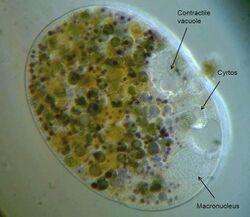Biology:Nassula
| Nassula | |
|---|---|

| |
| Nassula sp. | |
| Scientific classification | |
| Domain: | Eukaryota
|
| (unranked): | |
| (unranked): | Alveolata
|
| Phylum: | Ciliophora
|
| Subphylum: | |
| Class: | |
| Order: | Nassulida
|
| Family: | Nassulidae
|
| Genus: | Nassula Ehrenberg, 1833
|
Nassula is a genus of unicellular ciliates, belonging to the class Nassophorea. Like other members of the class, Nassula possesses a basket-like feeding apparatus (nasse, or cyrtos) made up of cytopharyngeal rods (nematodesmata), which are themselves composed of closely packed microtubules.[1][2][3] Nassula use this structure to ingest filamentous cyanobacteria, drawing individual strands of blue-green algae through the cytopharynx and into the body of the cell, where they are digested. As the algae are broken down, they can take on a variety of bright colours, which give Nassula a distinctive, variegated appearance under the microscope.
Description
The body is ovoid to elongate, and uniformly ciliated, with a single macronucleus and a partial hypostomial frange (synhymenium) running from the left side of the cell to the oral aperture.[4] When food is scarce, members of the genus have the ability to become dormant by forming a microbial cyst. Excystment can be induced by exposure to a medium inoculated with wild bacteria.[5]
Reproduction
Nassula reproduce asexually, by fission.[6] During reproduction, the cell is divided transversally. As in most ciliates (with the exception of the Karyorelictea) the macronucleus splits, during division, and the micronuclei also undergo mitosis.
While fission is an asexual process, it may be preceded by conjugation, during which compatible mating individuals come together and transfer genetic material across a cytoplasmic link. In conjugation, the micronuclei of each cell undergo meiosis, and haploid micronuclei are then exchanged from one cell to the other. After sexual exchange has occurred, both conjugants will divide by fission.[7]
Video Gallery
| File:Nassula Ciliate Cell Division.ogv | File:Nassula ornata details.ogv | File:Nassula consuming strands of cyanobacteria.ogv | File:Nassula a colorful ciliate detail of cytopharyngea.ogv |
Species list
References
- ↑ Tucker JB (December 1968). "Fine structure and function of the cytopharyngeal basket in the ciliate Nassula". Journal of Cell Science 3 (4): 493–514. doi:10.1242/jcs.3.4.493. PMID 4974275. http://jcs.biologists.org/cgi/pmidlookup?view=long&pmid=4974275.
- ↑ Tucker JB (March 1970). "Morphogenesis of a large microtubular organelle and its association with basal bodies in the ciliate Nassula". Journal of Cell Science 6 (2): 385–429. doi:10.1242/jcs.6.2.385. PMID 4986841. http://jcs.biologists.org/cgi/pmidlookup?view=long&pmid=4986841.
- ↑ Vigues, Bernard; Blanchard, Marie-Pierre; Bouchard, Philippe (1999). "Centrin-like filaments in the cytopharyngeal apparatus of the ciliates Nassula and Furgasonia: evidence for a relationship with microtubular structures". Cell Motility and the Cytoskeleton 43 (1): 72–81. doi:10.1002/(SICI)1097-0169(1999)43:1<72::AID-CM8>3.0.CO;2-U. PMID 10340705.
- ↑ Carey, Phillip G. (1992). Marine Interstitial Ciliates: An Illustrated Key. Chapman and Hall. p. 112. ISBN 978-0-412-40610-2.
- ↑ Beers CD (February 1966). "The excystment process in the ciliate Nassula ornata Ehrbg". The Journal of Protozoology 13 (1): 79–83. doi:10.1111/j.1550-7408.1966.tb01874.x. PMID 4958004.
- ↑ Tucker JB (December 1967). "Changes in nuclear structure during binary fission in the ciliate Nassula". Journal of Cell Science 2 (4): 481–98. doi:10.1242/jcs.2.4.481. PMID 4965925. http://jcs.biologists.org/cgi/pmidlookup?view=long&pmid=4965925.
- ↑ The Ciliated Protozoa - Characterization, Classification, and Guide to the | Springer. Springer. 2008. p. 23. ISBN 9781402082382. https://www.springer.com/gp/book/9781402082382.
Wikidata ☰ Q6967689 entry
 |

